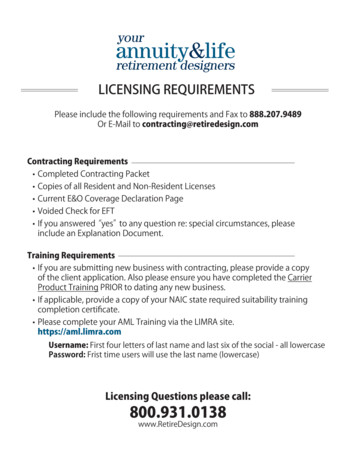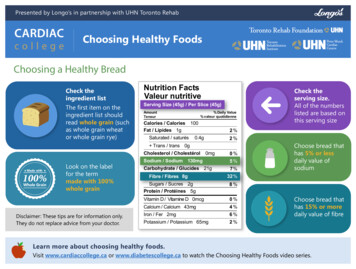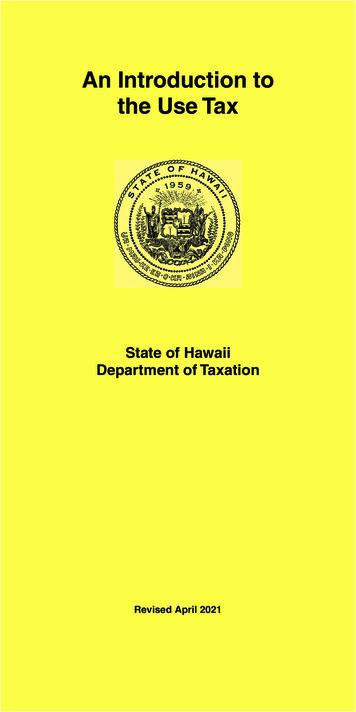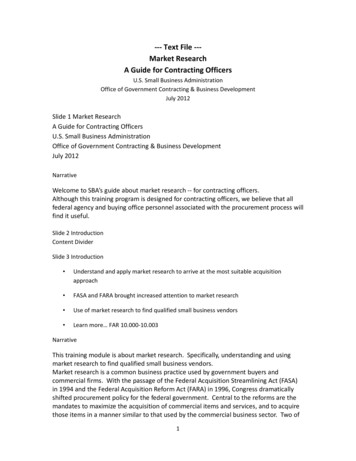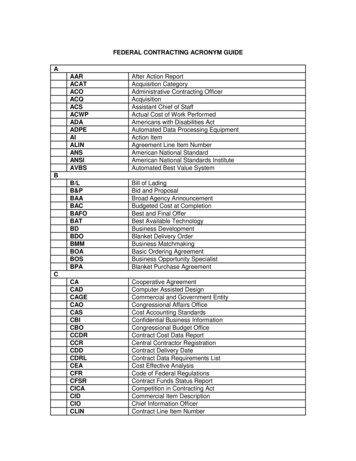
Transcription
CHOOSINGBEST VALUEIN CONTRACTINGFOOD SERVICESA guide for private andpublic client organisationsWITH FINANCIALSUPPORT OF
CHOOSING BEST VALUE IN CONTRACTING FOOD SERVICES — A GUIDE FOR PRIVATE AND PUBLIC CLIENT ORGANISATIONSCHOOSINGBEST VALUEIN CONTRACTINGFOOD SERVICESA guide for private andpublic client organisations3
CHOOSING BEST VALUE IN CONTRACTING FOOD SERVICES — A GUIDE FOR PRIVATE AND PUBLIC CLIENT ORGANISATIONSTABLE OF CONTENTExecutive summary6Glossary9Introduction11How to use the guide12Chapter I – Understanding the need for quality food services13I. 1. Why a guide for contracting food services?13I. 2. The contract catering sector at a glance15I. 2. a. In numbers15I. 2. b. Stakeholders16I. 3. Why quality matters19Chapter II – EU legislative context21II. 1. EU Directive on Public Procurement21II. 2. EU public procurement strategy22Chapter III – Defining quality23III. 1. Qualitative criteria to consider24III. 1. a. Recruitment & Working conditions of staff24III. 1. b. Hygiene & Food Safety26III. 1. c. Nutritional criteria & quality of the food26III. 1. d. Sustainability considerations27Chapter IV – Building quality considerations into tendersIV. 1. Before the tender2929IV. 1. a. Pre-site visits29IV. 1. b. Drawing up the specifications and criteria30IV. 2. During the tender33IV. 2. a. Comparing & selecting tenders33IV. 2. b. Identifying abnormally low tenders35IV. 2. c. Considerations for awarding the contract35IV. 3. After the tender36IV. 3. a. Ensuring proper execution of the contract36IV. 3. b. Adapting contracts to reflect changing circumstances374
CHOOSING BEST VALUE IN CONTRACTING FOOD SERVICES — A GUIDE FOR PRIVATE AND PUBLIC CLIENT ORGANISATIONSAnnex I - Defining the content of the serviceDivision of responsibilities between the client organisation and the service providerAnnex II – Evaluation Guidelines: An example ofhow to Award Contracts Based on Quality Criteria383841Step 1 – Measuring the importance of quality over price41Step 2- Defining the importance of differentcategories and specific quality criteria42Category42Attribution of importance42Step 3 – Quality evaluation453. 1. Price evaluation453. 2. Quality Evaluation453. 3. Definition of Scoring Criteria463. 4. Example473. 5. Result53Annex III – Legal provisions541. EU legislative context in detail541.1. EU Directive on Public Procurement542. Exclusion, selection and award criteria592. 1. Exclusion criteria592. 2. Selection criteria (specifications required)612. 3. Award criteria633. Contract Notices635
CHOOSING BEST VALUE IN CONTRACTING FOOD SERVICES — A GUIDE FOR PRIVATE AND PUBLIC CLIENT ORGANISATIONSEXECUTIVE SUMMARYThe following guide is the result of consultations between representatives of the industry andsocial partners across EU Member States on how to ensure that the best price/quality ratiois valued in the procurement of services in the contract catering sector. This guide has beenestablished with the support of the European Commission.While quality is always a key consideration, client organisations usually rely on price as a moreobjective award criteria which is less likely to be challenged. Client organisations are also oftenfaced with strict economic constraints which leads to the almost exclusive application of thelowest price criteria. Competing on price alone can lead to a race to the bottom in terms of theactual service provided and the working conditions in practice – with huge potential losses forthe clients, workers, users and the industry as a whole.The contract catering sector is highly competitive, and tendering companies along with clientorganisations should promote a competition that is not based on prices alone but also on thequality of the service offering. The contract catering sector is also characterised by its end userswho are captive – covering consumer groups such as patients in hospitals or schoolchildren,the end users generally have little to no choice over the service which they receive.At the same time, being a labour-intensive sector, contract catering companies dependon their workforce to provide quality services. Making sure a proper investment is madein the human resources required is fundamental, for instance providing adequate trainingof staff so that skills can better match the client organisation’s specific needs. The socialdimension is reflected throughout the guide, particularly the need to respect the sectoralcollective agreements in place. The guide also provides an overview of EU legislation whichis applicable to public procurement and explains its relevance for the contract catering sector.Although there is widespread agreement across the sector that selecting best value meansvaluing quality over price, quality remains difficult to measure. To shed light on how qualitycan be defined and weighted, we look at several different categories in which quality is ofprime importance – from working conditions to nutritional criteria, hygiene and sustainability– and provide insights into how to build these quality considerations into the different stagesof the tendering process. To illustrate this the guide draws on best case practices acrossdifferent EU Member States.6
CHOOSING BEST VALUE IN CONTRACTING FOOD SERVICES — A GUIDE FOR PRIVATE AND PUBLIC CLIENT ORGANISATIONSSix main recommendations are made in this guide to support client organisations in carryingout a tendering process:1. Choose on the basis of the best quality / price ratio: In defining thequality criteria which matter to them and which will form the basis of the callfor tenders, client organisations should leave space for quality to be taken intoaccount when choosing the best offer and should not set overly restrictive qualitycriteria. In defining quality criteria clients must also take account of guides and rulesalready in place, particularly existing collective sectoral agreements. Following suchpre-established standards not only avoids client organisations having to draw up newstandards for each tender, but also ensures that companies have a uniform way ofproviding a service, thereby creating a level-playing field. Competition can then bebased more on quality and creativity.2. Reject abnormally low tenders that drive down the quality of thecontract catering services provided, often at the expense of adequate workingconditions.3. Define a clear division of responsibilities: While the service itself willalmost exclusively be delivered by the service provider, the client organisationalso has responsibilities to assume regarding the premises on which the serviceprovider will operate. It is up to the client organisation to enable quality services byproviding the adequate infrastructure (e.g. for service providers to meet sustainabilitycriteria, the premises must have appropriate infrastructure for food preservation anddealing with waste).4. Engage all parties at the beginning of the process: It is in theclient organisation’s interest to ensure that tenderers have as muchinformation as possible on the premises, users and quality of servicerequired. This guide recommends that the client organisation organise site visits andQ&A sessions at the very beginning of the tendering process to enable tenderers todevise better tailored offers.7
CHOOSING BEST VALUE IN CONTRACTING FOOD SERVICES — A GUIDE FOR PRIVATE AND PUBLIC CLIENT ORGANISATIONS5. Respect clearly established timelines: While most tenders haveclear indications on timing and deadlines for tenderers to respect, the clientorganisation should also commit to deadlines on assessing offers and taking adecision. If the assessment of offers takes too long to complete, the offers may nolonger reflect the financial reality (e.g. inflation, salary indexation).6. Ensure compliance with the contract: Once a decision has beenmade and a service provider has been awarded the contract, the clientorganisation should monitor regularly whether the contract’s provisions arebeing fully respected. This is very important to ensure sound competition on themarket that is based on compliance with agreed quality standards. Contracts shouldalso include an annual revision clause to reflect changing circumstances (e.g. inflation,salary indexation).Of course, quality is also subjective and depends a great deal on the specific requirements ofthe client organisation, which is why this guide offers a pallet of quality considerations whichclient organisations may consider. In annex, we suggest a basic methodology to score andweight the different criteria as well as a basic step-by-step guide to carrying out a tenderingprocedure.8
CHOOSING BEST VALUE IN CONTRACTING FOOD SERVICES — A GUIDE FOR PRIVATE AND PUBLIC CLIENT ORGANISATIONSGLOSSARYAbnormally low tender: tenders where the price or costs proposed appear to be abnormallylow in relation to the works, supplies or services. To assess this it is useful to reflect on thelabour cost and the total costs of the contract. The Public Procurement Directive foresees thattenderers shall be excluded if the abnormally low price is due to lack of respect for the sectoralcollective agreements or social or labour laws.Best value: this concept seeks to establish a system according to which various elementsrelating to the quality of service are scaled and weighted to the price, in order to assess theoffer that best suits the specific needs and preferences of the client and thereby presents theeconomically most advantageous offer, whilst respecting sectoral collective agreements inplace.Call for tenders: procedures applied to generate offers from companies competing for work,supply or service contracts in the framework of procurement.Client organisation: tendering organisation or contracting authority looking to buy foodservices. In this guide, client means tendering companies and contracting authorities in andoutside of the European Union, preparing to or currently buying food services.Contract: this is the set of terms binding the client organisation to the food services companyin the context of the provision of services. The contract refers to a public invitation to tender,or to the relationship between the client and the service provider (the food services company).HACCP: HAZARD ANALYSIS CONTROL CRITICAL POINT (set of principles to analyserisks and control critical points). HACCP allows to ensure food is protected from biological,chemical, and physical hazards in production processes that can cause the finished productto be unsafe. The HACCP system is relevant at all stages of the food service, from receptionand storage of goods to food production and preparation processes including packaging anddistribution.Service provider: in this guide, this is the food services or contract catering company.Successful tenderer: the undertaking to which the contract is awarded.Tenderer: the undertaking applying as a candidate to take part in the tendering procedureorganised by the client.Tender: the offer which is submitted by the service provider in response to the call for tenders.9
CHOOSING BEST VALUE IN CONTRACTING FOOD SERVICES — A GUIDE FOR PRIVATE AND PUBLIC CLIENT ORGANISATIONSTender may also refer to the system by which the realisation of a construction or a service,usually of a public nature, is awarded to the person or company that offers the best conditions.Tendering procedure: competition between various providers to perform a contract. Theconcept of invitation to tender refers specifically to the awarding of a contract in the publicor private sector. Invitations to tender are by nature more regulated in the public than in theprivate sector, with legal deadlines for advertising (the announcement of the tender and theannouncement of the award).Transfer of undertakings: A transfer of undertakings occurs when a business or partof a business is taken over by another employer as a result of a merger or transfer of themanagement, in application of the relevant national provisions implementing EU Directive2001/23/EC on the approximation of the laws of the Member States relating to thesafeguarding of employees’ rights in the event of transfers of undertakings, businesses orparts of undertakings or businesses.User: “final consumer”, the consumer (e.g. students/pupils, workers, seniors or patients) usingthe service provider’s service. In the contract catering sector users are defined by their captivenature – i.e. they often have no or few opportunities to choose what they eat or where; this isdefined by the client organisation on their behalf.10
CHOOSING BEST VALUE IN CONTRACTING FOOD SERVICES — A GUIDE FOR PRIVATE AND PUBLIC CLIENT ORGANISATIONSINTRODUCTIONThis guide aims to assist public bodies and private enterprises in selecting high quality serviceproviders in tenders for contracting food services. It was developed by the social partners inthe contract catering sector, FoodServiceEurope (the federation representing the contractcatering industry at EU level) and EFFAT (European Federation of Food, Agriculture andTourism Trade Unions, the federation representing workers in the contract catering sector), inclose cooperation with social partners and industry representatives from across EU MemberStates and with the support of the European Commission. This guide seeks to encourageclient organisations to give due consideration to quality criteria in awarding contracts, and notto limit selection to the lowest price offer.Setting strong guidelines is all the more important in a sector where quality has a genuineimpact on user experience, and where the risks resulting from low quality services are high.Dealing with vulnerable users such as patients in hospitals, seniors living in retirementhomes or school children, the sector needs to guarantee exceptionally high hygienestandards; dealing with perishable goods, the sector needs to guarantee quality produce andconservation. These prerequisites are matched by a number of quality considerations whichare inherent to the contract catering sector, such as nutritional values, choice, sustainability orethical considerations.This guide results from a strong commitment from all sides of the sector to bring theseconsiderations to the forefront in decisions on awarding contracts in food service tenderingprocedures. As such, this guide aims to offer guidance on how to define quality in the sector,what to consider in drawing up quality criteria, and how to value quality over price in selectingservice providers. It is structured as follows:Chapter I offers an overview of the contract catering sector and lays out the rationale forhaving such a guide in place. It looks at the specificities of the user groups, and draws somenecessary distinctions among the various segments.Chapter II lays out the EU regulatory framework within which these guidelines have beenestablished. Although the contract catering sector falls within the special treatment regime forEU Regulation on public procurement, EU legislation still offers valuable insights as to how tostrike an appropriate balance between price and quality. A more detailed breakdown of EUlegislation pertaining to public procurement is then provided in Annex III.Chapter III delves into the definition of quality and offers a wide pallet of criteria for clientorganisations to consider in the selection procedure. To better illustrate how quality can bemeasured, this section also provides best practices from across Europe.Chapter IV looks at how quality considerations can be applied in practice throughout thetendering and selection procedure. It highlights the need to consider the users’ expectationsand offers guidelines as to how to give higher consideration to higher quality offers. It alsohighlights the need to put in place adequate mechanisms for monitoring and evaluation inorder to ensure a proper execution of the contract.11
CHOOSING BEST VALUE IN CONTRACTING FOOD SERVICES — A GUIDE FOR PRIVATE AND PUBLIC CLIENT ORGANISATIONSBased on the criteria established above, the annex of this guide provides a tool box for clientorganisations to draw up quality criteria, carry out tendering procedures and award contractsand details how EU legislation on public procurement can be applied to the sector (evenwhere it is not mandatory).WHAT THIS GUIDE PROVIDES An overview of the sector & its specificities A practical digest of EU legislation and initiatives in this field Guidelines for organisations contracting food services on how to define quality Best practices from across Europe A toolbox for organisations contracting food services to select best value intendering proceduresHow to use the guideUnderstanding thecontract cateringsectorp. 13-20Tendering procedurep. 33-37Annex I p. 38-46Defining qualityp. 23-28Annex II p. 41-44Examples & toolsAnnex I p. 38-40Annex II p. 41-53Annex III p. 59-66Drawing up criteriap. 30-32Annex II p. 41-44Annex III p. 59-63Tips &recommendationsp. 23-37Users of the guide should:1. Assess what quality criteria to value in the service to be provided, taking inspiration fromcriteria defined in Chapter III and further laid out in Annex II;2. Set their tendering specifications, respecting sectoral collective agreements in place andtaking inspiration from EU legislation (Chapter II and Annex III) or national best practices(Chapter III);3. Carry out a clear & time bound tendering procedure, taking inspiration from steps laidout in Chapter IV and further exemplified in Annexes I, II & III.12
CHOOSING BEST VALUE IN CONTRACTING FOOD SERVICES — A GUIDE FOR PRIVATE AND PUBLIC CLIENT ORGANISATIONSCHAPTER I – UNDERSTANDING THENEED FOR QUALITY FOOD SERVICESI. 1. Why a guide for contracting food services?The contract catering sector is an important contributor to the European economy, but alsofaces some important challenges. With a high number of companies operating in a relativelylimited commercial space, competition can be fierce. But the major challenges arise from thespecificities of this sector that is governed by a three-party relationship between the contractcatering operator, the client organisation and the user. Contract catering companies often relyon contracts with clients of limited duration, requiring flexibility to which operators and theirworkforce need to adapt. Client organisations are also generally not the users of the service,which can result in a tendency to opt for cheaper offers at the expense of quality of the mealsand service provided.Competing on price alone can drive companies which offer more tailored or qualitativeservices out of the market and, even worse, to a race to the bottom in terms of the qualityof service provided and the working conditions – with huge potential losses for the clients,workers, users and the industry as a whole.This guide aims to fight this trend by putting quality at the core of tenders for food services andavoiding any risks of distorted and unfair competition. By offering guidance on how qualitycan be valued by client organisations, we aim to facilitate the awarding of contracts basedon the best quality/price ratio, to increase transparency in the process and to create greatersynergies between the client organisations and the tenderers.The food services sector needs to meet, but also strive to surpass, user expectations.European users expect quality; a wide choice of food that is varied regularly; comfortand an aesthetically pleasing setting (acoustics, decoration, furniture, etc.); attractive,varied methods of distribution; a focus on nutrition; impeccable hygiene and safetyof foodstuffs and information regarding the meals served. Meeting all these criteria whilststaying mindful of price can be a challenge, particularly in a sector which faces increasedcompetition from commercial services.In a sector highly dependent on its workforce, quality also means ensuring adequate workingconditions and remuneration levels, in full respect of sectoral collective agreements in place,appropriate training, health and safety provisions, constructive employer-employee relations,and acknowledging value where service providers go beyond legal or contractual obligations.13
CHOOSING BEST VALUE IN CONTRACTING FOOD SERVICES — A GUIDE FOR PRIVATE AND PUBLIC CLIENT ORGANISATIONSClient organisations contracting food services do not have an easy job. They must choosethe best solution that takes into account their needs and constraints, in particular financialconstraints, while complying with professional practices and the many regulatory provisionsinherent to food services. While quality is always a key consideration, client organisationsusually rely on price as a more objective award criteria which is less likely to be challenged. Asthey are often also faced with strict economic constraints this can lead to the almost exclusiveapplication of the lowest price criteria.This guide will assist client organisations contracting food services in their efforts toorganise a tendering procedure that will result in the selection of the offer which best matchesthe needs of all groups involved: client organisations, service providers and users.This guide is also intended to raise awareness among client organisations contracting foodservices of the importance of ensuring that quality is thoroughly controlled throughout thecontract period. Indeed, a lack of proper controls leads to distortion of competition.Putting quality at the heart of the award decision together with price is also expected to fosterthose food services companies that are eager to promote respect for social values withintheir undertakings beyond the sectoral collective agreements in place, or that have a strongerfocus on quality in their service offering.In brief, and building on a previous and first guide published in 2006, this guide aims topromote more transparency in the selection and award process, to assist in quantifyingquality to ensure a better reflection of the needs of all parties involved and to strive forthe highest quality standards in the contract catering sector.14
CHOOSING BEST VALUE IN CONTRACTING FOOD SERVICES — A GUIDE FOR PRIVATE AND PUBLIC CLIENT ORGANISATIONSI. 2. The contract catering sector at a glanceContract catering is a unique sector and significantly different to other forms of restaurantservices – services in contract catering are outsourced by a third-party organisation to aspecialised company on a contractual base.The contract catering sector in the EU comprises the services needed to prepare and providemeals to people working and/or living in communities: administrations, crèches, schools,hospitals, retirement homes, prisons, barracks, etc. When these activities are entrusted to aservice provider, this is called contract catering.Contract catering has the following characteristics: the existence of a written contract between the client organisation and the serviceprovider; an obligation to comply with existing agreements in place, e.g. sectoral collectiveagreements in force in the relevant country or other conditions applicable to atransfer of management under the EU rules on transfers of undertakings; a well-defined group of users which often is not able to choose the service which itenjoys (so-called ‘captive consumers’); special constraints arising from the fact that the service is provided on the premisesof the client organisation, in line with a method of organisation specific to thatorganisation; a social price that is usually significantly lower than the price of a meal in commercialfood services.I. 2. a. In numbersA survey conducted by Gira Food Service across 15 EU countries found that in 2013, contractcaterers produced 6,1 billion meals with a total turnover of 25,4 billion euros.The 15 analysed countries represented: 88% of the total EU 28 members’ total social food service market evaluated at 82 billion (when including in-house provision of services); 93% of the total EU 28 members’ contracted turnover ( 27,3 billion).15
CHOOSING BEST VALUE IN CONTRACTING FOOD SERVICES — A GUIDE FOR PRIVATE AND PUBLIC CLIENT ORGANISATIONSFOOD SERVICES IN EUROPE AT A GLANCE600,000 people employedin the sectoracross Europe6 billions meals preparedeach year67 millionconsumersserved every dayTotal turnoverof 24,4 billion euros each yearContinued growthDespite unprecedented progress over the past decade in online developments andtelecommunications, work commuting distances continue to grow for many people, as doesthe trend of both parents working outside of the home.The outsourcing of services has amplified across all sectors due to businesses and otherorganisations - both in the private and public sector - increasingly realising that outsourcingfood services allows for a greater focus of attention, time and resources on their core business,as well as provides better value for the client organisation and the final user.In parallel, contract catering companies have also become more professional in their serviceprovision, for instance offering nutrition specialists to design tailor-made menus for specificgroups of clients e.g. children in schools.I. 2. b. StakeholdersWho are the client organisations?The clients in the contract catering sector are organisations which subcontract the preparationand provision of meals to a service provider. These can be both private and public bodiesand cover enterprises as well as public administrations, kindergartens, schools, hospitals,retirement homes, prisons, barracks, etc.Who are the service providers?The service providers range from pan-European or global companies to local companies,and their role may range from simple technical assistance, to provision of prepared meals,to full management of the food services in the client facilities. ‘Service providers’ includes thestaff which is providing the service under the company’s contract. Companies are obliged tocomply with the obligations deriving from the Council Directive on safeguarding of employees’rights in the event of transfers of undertakings, as implemented in national frameworks.16
CHOOSING BEST VALUE IN CONTRACTING FOOD SERVICES — A GUIDE FOR PRIVATE AND PUBLIC CLIENT ORGANISATIONSWho are the users?The contract catering sector is somewhat unique in that it needs to be tailored to the specificneeds of different types of users that define to a large extent the type of services which will berequired. This is because the users in the sector are often vulnerable, with a very specific setof requirements when it comes to food: In schools, the users are schoolchildren: dietary requirements such as nutritionalvalues, varied and balanced meals are crucial, as well the presentation of foodand kindness of staff. Schools may in particular contract staff to take care ofschoolchildren during the food service, who have to comply with the general rulesand instructions received from the school’s management as well as the requirementsestablished by the educational authority, health authority or other authority withcompetence in the matter. They are in charge of maintenance of order and reportingincidents to their superior and the director of the school. They may also be requiredto assist schoolchildren in some tasks such as peeling food. They therefore haveto have basic knowledge of first aid, sanitary technical regulations and hygienicsanitary conditions of food, beverages and their conservation. In schools, manyservice providers give menus adapted to schoolchildren with food allergies and foodintolerances. In hospitals, the users are patients: meals must be tailored to individual needs, andhygiene is paramount to avoid any risk of cross-contamination. Single-use plastic anddealing with disposal of waste are also key elements which distinguish food servicesin hospitals from those in other segments, as well as the need to deliver meals atspecific times. In care homes, users are the elderly: this may imply special dietary requirements aswell as more assistance in the provision of the meals. In private companies or in public administration, the users are employees: this mayimply a greater demand of choice and variation, and increasingly more value given toextended quality criteria such as food being responsibly sourced, of biological origin,or from local producers.Other users include army and State Security forces, local security forces in barracks; prisonersin prisons; students in universities, etc.17
CHOOSING BEST VALUE IN CONTRACTING FOOD SERVICES — A GUIDE FOR PRIVATE AND PUBLIC CLIENT nked by contractUSERSFOOD SERVICECOMPANYoetciervsseidovrPUsers in the contract catering sector are generally‘captive consumers’, as they have little to nochoice over the service that is provided to them.DEFINING QUALITY FOR SCHOOLCHILDREN - FOODSERVICEEUROPEFoodServiceEurope has developed a Model School Food Standard, with theaim of improving the quality of food in schools and the ability of European childrento learn and maintain healthy dietary practices.The Model School Food Standard provides guidance on food and drinks providedby the school during and outside lunchtime, including both food-based andnutrient-based recommendations for the main age groups represented in schoolsettings in Europe.In line with the most fundamental principle of a healthy diet, variety is at the coreof this standard, recommending that schools provide a wide range of foods acrossthe week, offering diversity in fruit, vegetables, grains, starch, meat, fish and dairyproducts served.In addition to food-based guidance, i.e. recommendations for the variety of foodsto be provided and related frequency, the standard provides nutrient-basedrecommendations, to ensure that the foods provided are of high nutritionalquality and that the composition of school meals with these foods contributes tonutritional balance.It also recommends that schools make reasonable adjustments for pupils withparticular requirements, for example to re
Annex II - Evaluation Guidelines: An example of how to Award Contracts Based on Quality Criteria 41 Step 1 - Measuring the importance of quality over price 41 Step 2- Defining the importance of different categories and specific quality criteria 42 Category42 Attribution of importance 42 Step 3 - Quality evaluation 45 3. 1.

